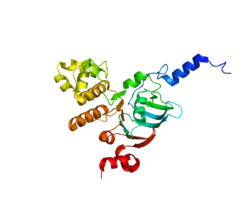| ABCB6 | |||||||||||||||||||||||||||||||||||||||||||||||||||
|---|---|---|---|---|---|---|---|---|---|---|---|---|---|---|---|---|---|---|---|---|---|---|---|---|---|---|---|---|---|---|---|---|---|---|---|---|---|---|---|---|---|---|---|---|---|---|---|---|---|---|---|
 | |||||||||||||||||||||||||||||||||||||||||||||||||||
| |||||||||||||||||||||||||||||||||||||||||||||||||||
| Identifiers | |||||||||||||||||||||||||||||||||||||||||||||||||||
| Aliases | ABCB6, ABC, ABC14, DUH3, LAN, MCOPCB7, MTABC3, PRP, umat, PSHK2, ATP binding cassette subfamily B member 6 (Langereis blood group) | ||||||||||||||||||||||||||||||||||||||||||||||||||
| External IDs | OMIM: 605452 MGI: 1921354 HomoloGene: 11375 GeneCards: ABCB6 | ||||||||||||||||||||||||||||||||||||||||||||||||||
| |||||||||||||||||||||||||||||||||||||||||||||||||||
| |||||||||||||||||||||||||||||||||||||||||||||||||||
| |||||||||||||||||||||||||||||||||||||||||||||||||||
| |||||||||||||||||||||||||||||||||||||||||||||||||||
| Wikidata | |||||||||||||||||||||||||||||||||||||||||||||||||||
| |||||||||||||||||||||||||||||||||||||||||||||||||||
ATP-binding cassette super-family B member 6, mitochondrial is a protein that in humans is encoded by the ABCB6 gene.[5][6][7]
The membrane-associated protein encoded by this gene is a member of the superfamily of ATP-binding cassette (ABC) transporters. ABC proteins transport various molecules across extra- and intra-cellular membranes. ABC genes are divided into seven distinct subfamilies (ABC1, MDR/TAP, MRP, ALD, OABP, GCN20, White). This protein is a member of the MDR/TAP subfamily. Members of the MDR/TAP subfamily are involved in multidrug resistance as well as antigen presentation. This half-transporter likely plays a role in mitochondrial function. Localized to 2q26, this gene is considered a candidate gene for Dyschromatosis Universalis Hereditaria, a disorder of skin pigment metabolism.[7] The protein also carries the Lan antigen, which defines the Lan blood group system.[8]
See also
References
- 1 2 3 GRCh38: Ensembl release 89: ENSG00000115657 - Ensembl, May 2017
- 1 2 3 GRCm38: Ensembl release 89: ENSMUSG00000026198 - Ensembl, May 2017
- ↑ "Human PubMed Reference:". National Center for Biotechnology Information, U.S. National Library of Medicine.
- ↑ "Mouse PubMed Reference:". National Center for Biotechnology Information, U.S. National Library of Medicine.
- ↑ Allikmets R, Gerrard B, Hutchinson A, Dean M (Feb 1997). "Characterization of the human ABC superfamily: isolation and mapping of 21 new genes using the expressed sequence tags database". Hum Mol Genet. 5 (10): 1649–55. doi:10.1093/hmg/5.10.1649. PMID 8894702.
- ↑ Yu W, Andersson B, Worley KC, Muzny DM, Ding Y, Liu W, Ricafrente JY, Wentland MA, Lennon G, Gibbs RA (Jun 1997). "Large-Scale Concatenation cDNA Sequencing". Genome Res. 7 (4): 353–8. doi:10.1101/gr.7.4.353. PMC 139146. PMID 9110174.
- 1 2 Zhang C, Li D, Zhang J, Chen X (Mar 2013). "Mutations in ABCB6 Cause Dyschromatosis Universalis Hereditaria". J Invest Dermatol. 133 (9): 2221–8. doi:10.1038/jid.2013.145. PMID 23519333.
- ↑ Bocchini CA (2015). "#111600 - BLOOD GROUP, LANGEREIS SYSTEM; LAN". Online Mendelian Inheritance in Man. Retrieved 16 May 2020.
Further reading
- Paterson JK, Shukla S, Black CM, et al. (2007). "Human ABCB6 localizes to both the outer mitochondrial membrane and the plasma membrane". Biochemistry. 46 (33): 9443–52. doi:10.1021/bi700015m. PMID 17661442.
- Krishnamurthy PC, Du G, Fukuda Y, et al. (2006). "Identification of a mammalian mitochondrial porphyrin transporter". Nature. 443 (7111): 586–9. Bibcode:2006Natur.443..586K. doi:10.1038/nature05125. PMID 17006453. S2CID 4300410.
- Kurashima-Ito K, Ikeya T, Senbongi H, et al. (2006). "Heteronuclear multidimensional NMR and homology modelling studies of the C-terminal nucleotide-binding domain of the human mitochondrial ABC transporter ABCB6". J. Biomol. NMR. 35 (1): 53–71. doi:10.1007/s10858-006-9000-6. PMID 16791740. S2CID 42668666.
- Gerhard DS, Wagner L, Feingold EA, et al. (2004). "The Status, Quality, and Expansion of the NIH Full-Length cDNA Project: The Mammalian Gene Collection (MGC)". Genome Res. 14 (10B): 2121–7. doi:10.1101/gr.2596504. PMC 528928. PMID 15489334.
- Ota T, Suzuki Y, Nishikawa T, et al. (2004). "Complete sequencing and characterization of 21,243 full-length human cDNAs". Nat. Genet. 36 (1): 40–5. doi:10.1038/ng1285. PMID 14702039.
- Strausberg RL, Feingold EA, Grouse LH, et al. (2003). "Generation and initial analysis of more than 15,000 full-length human and mouse cDNA sequences". Proc. Natl. Acad. Sci. U.S.A. 99 (26): 16899–903. Bibcode:2002PNAS...9916899M. doi:10.1073/pnas.242603899. PMC 139241. PMID 12477932.
- Visapää I, Fellman V, Lanyi L, Peltonen L (2002). "ABCB6 (MTABC3) excluded as the causative gene for the growth retardation syndrome with aminoaciduria, cholestasis, iron overload, and lactacidosis". Am. J. Med. Genet. 109 (3): 202–5. doi:10.1002/ajmg.10331. PMID 11977179.
- Emadi-Konjin HP, Zhang H, Anandan V, et al. (2002). "Isolation of a genomic clone containing the promoter region of the human ATP binding cassette (ABC) transporter, ABCB6". Biochim. Biophys. Acta. 1574 (2): 117–30. doi:10.1016/s0167-4781(01)00340-2. PMID 11955620.
- Mitsuhashi N, Miki T, Senbongi H, et al. (2000). "MTABC3, a novel mitochondrial ATP-binding cassette protein involved in iron homeostasis". J. Biol. Chem. 275 (23): 17536–40. doi:10.1074/jbc.275.23.17536. PMID 10837493.
- Furuya KN, Bradley G, Sun D, et al. (1997). "Identification of a new P-glycoprotein-like ATP-binding cassette transporter gene that is overexpressed during hepatocarcinogenesis". Cancer Res. 57 (17): 3708–16. PMID 9288777.
- Andersson B, Wentland MA, Ricafrente JY, et al. (1996). "A "double adaptor" method for improved shotgun library construction". Anal. Biochem. 236 (1): 107–13. doi:10.1006/abio.1996.0138. PMID 8619474.
External links
- ABCB6+protein,+human at the U.S. National Library of Medicine Medical Subject Headings (MeSH)
- ABCB6 human gene location in the UCSC Genome Browser.
- ABCB6 human gene details in the UCSC Genome Browser.
- Overview of all the structural information available in the PDB for UniProt: Q9NP58 (ATP-binding cassette sub-family B member 6, mitochondrial) at the PDBe-KB.
This article incorporates text from the United States National Library of Medicine, which is in the public domain.




